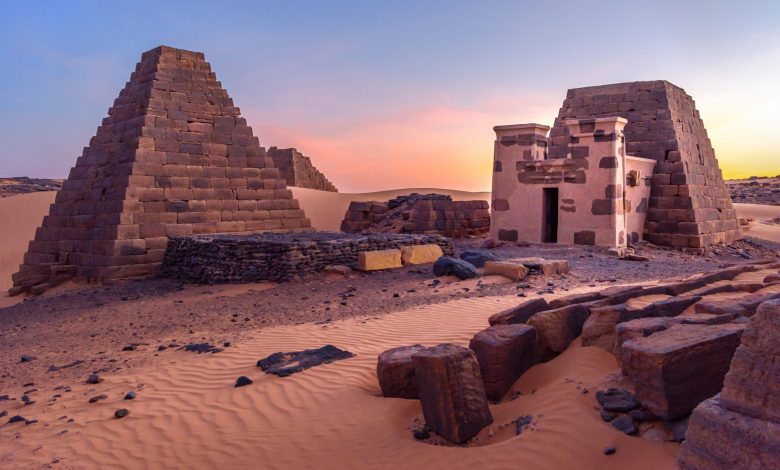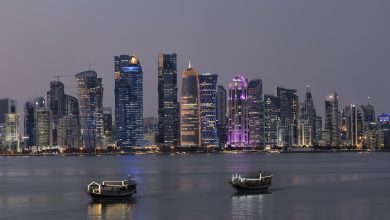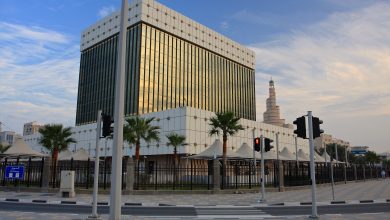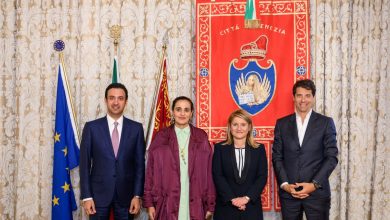
Qatar Museums delegation visits Sudan’s archaeology sites
وفد «متاحف قطر» يزور مواقع الآثار السودانية
The project, along with its work in Nubian archeology sites, involves more than 40 missions. The delegation was led by QM CEO Ahmed al-Namla, which included Rapporteur of the Supreme Committee for the project Mohamed Juma al-Kuwari, and Rapporteur of the Scientific Committee of the project Abdullatif al-Jasmi. “We are very proud of this achievement, the result of a strong co-operation between QM and our brothers in Sudan,” al-Namla said, highlighting “the great achievements attained by the Qatari mission.”
He cited the support provided by Qatar to preserve what was described as “a valuable and important human heritage.”

The site contains a royal city with the remains of temples, palaces, three baths, groups of pyramids, quarries and piles of remains of the iron industry that Meroe is famous for.

The delegation, accompanied by ambassador Abdul Rahman al-Kubaisi, was led by Ahmed al-Namla, along with Mohamed Juma al-Kuwari and Abdullatif al-Jasmi.

The delegation visited Qatari projects in Sudan.
Al-Namla also underlined QSAP’s achievements and discoveries which, over the past five years, have significantly contributed to developing tourism in Sudan. He thanked the German delegation, which has given Sudan a copy of Dr Friedrich Hinkel’s archive, stressing how this will greatly contribute to enriching the work conducted by German missions today.
The CEO noted that QSAP aims to highlight Sudan’s civilisation and support cultural tourism, training programmes and scientific research. He explained that through the archaeological discoveries, supported by Qatar, the project will have an impact not only on Sudan and its civilisation, but also on Arab and international heritage and history. This will in turn make Sudan a cultural attraction, creating economic returns from establishing tourist projects, museums, and visitor centres.
The QM delegation heard a detailed explanation from Dr Mahmoud Suleiman Mohamed Bashir, co-director of the Qatari mission and director of the World Heritage site “Meroe Island”, about the activities of the Qatari mission in Al Bajrawi, considered as one of the most important and highly visited archaeological sites in Sudan. Al Barjawi (Old Meroe) is the capital of the state of Meroe (4th century BC– 4th century AD). The site contains a royal city with the remains of temples, palaces, three baths, groups of pyramids, quarries and piles of remains of the iron industry that Meroe is famous for. The delegation also visited the Qatari projects, which included Doha Meroe, a world-class tourist village which includes two buildings, namely, “Archaeologist Harbour” and “Information Centre”, both of which are built in Nubian style.
Between the two facilities is a theatre that hosts various events. As part of the project, the entrance to the pyramids was changed from the western side to the southern side, to allow the pyramids to be seen from their main facades. The entrance is connected to a dirt road that starts from the information centre. The delegation then proceeded to visit pyramid No. 9, which was excavated at the beginning of the 20th century by the archaeologist Reisner.
The Qatari mission has re-excavated, studied, protected and restored the rooms of this pyramid to make them available to tourists.
The pyramid belonged to King Tabrika, who ruled Meroe from 207 to 86 BC, and its rooms can be accessed at 10m below the surface. The Qatari mission also dismantled, restored, and reinstalled the inscribed funerary temple for pyramid No. 2 which belonged to King Amani Khabal.
The delegation also visited the royal bath located within the royal city, which includes the remains of temples and palaces of the Meroe kings.
QSAP, under the framework of tourism management planning, is currently financing the construction of an external building that lies outside the bath and that will take the form of a small museum and includes archaeological pieces and information about the bath.
زار وفد من «متاحف قطر» منطقة البجراوية بالسودان، برفقة سعادة السيد عبدالرحمن بن علي الكبيسي سفير دولة قطر لدى جمهورية السودان، للوقوف على إنجازات ونشاطات البعثة القطرية لأهرامات السودان، إحدى أهم بعثات المشروع القطري السوداني لتنمية آثار النوبة، والبالغ عددها أكثر من 40 بعثة. وترأس الوفد السيد أحمد النملة الرئيس التنفيذي لـ «متاحف قطر»، وضم كلاً من: السيد محمد جمعة الكواري مقرر المجلس الأعلى للمشروع، والسيد عبداللطيف الجسمي مقرر اللجنة العلمية للمشروع.
عبّر السيد أحمد النملة عن سعادته بالإنجاز الكبير الذي حققته البعثة القطرية لأهرامات السودان في موقع البجراوية، وقال بهذا الخصوص: نحن فخورون بهذا الإنجاز الذي نتج عن التعاون بين متاحف قطر مع الجانب السوداني الشقيق، للحفاظ على الآثار السودانية، منوهاً بالدعم الكبير الذي قدمته دولة قطر للحفاظ على تراث إنساني قيّم ومهم.
اكتشافات عظيمة
كما أشار إلى أن المشروع القطري السوداني للآثار حقق خلال الخمس سنوات الماضية، إنجازات واكتشافات عظيمة تسهم في دعم السياحة في السودان، معرباً عن شكره وتقديره للبعثة الألمانية التي سلمت الجانب السوداني نسخة من الأرشيف الذي جمعه الدكتور فرديدريش هينكل حول نتائج البعثات الألمانية في السودان في مجال الآثار، مؤكداً أن ذلك سيسهم كثيراً في تطوير أداء البعثات الأثرية الألمانية التي تعمل في عدة مواقع.
أهداف عديدة
ونوه الرئيس التنفيذي لـ «متاحف قطر» بأن المشروع القطري السوداني للآثار له أهداف ومرامٍ عديدة، تتمثل في إبراز حضارة السودان للعالم ودعم السياحة الثقافية والبرامج التدريبية والبحث العلمي، لافتاً إلى أنه من خلال الاكتشافات الأثرية المصاحبة للمشروع، ستعمل دولة قطر على دعم هذه الجهود، مشيراً في الآن ذاته، إلى أن المشروع سيكون له أثره ليس فقط على السودان وحضارته بل على التراث والتاريخ العربي والعالمي، مما يجعل من السودان منطقة جذب ثقافي من جانب المهتمين بالتراث والآثار في العالم، إضافة إلى المردود الاقتصادي المتوقع من إقامة المشروعات السياحية والمتاحف ومراكز الزوار بالمناطق الأثرية.
واستمع الوفد إلى شرح مفصل من الدكتور محمود سليمان محمد بشير، المدير المشارك بالبعثة القطرية لأهرامات السودان ومدير موقع التراث العالمي «جزيرة مروي»، حول نشاطات البعثة القطرية لأهرامات السودان بموقع أهرامات البجراوية، والذي يعتبر من أهم المواقع الأثرية في السودان، الذي يستقبل العدد الأكبر من الزوار بحكم شهرته العالمية كأحد مواقع التراث العالمي.
البجراوية
وتعتبر البجراوية -مروي القديمة- عاصمة دولة مروي «القرن الرابع قبل الميلاد – القرن الرابع الميلادي»، ويحتوي الموقع على مدينة ملكية بها بقايا معابد وقصور وحمامات ثلاثة ومجموعات من الأهرامات ومحاجر وأكوام لبقايا صناعة الحديد التي اشتهرت بها مروي.
كما قام الوفد بزيارة المشاريع القطرية والتي شملت دوحة مروي، وهي قرية سياحية بمواصفات راقية بدأت بمبنيين وهما «إيواء الآثاريين» و«مركز المعلومات»، وكلاهما مبني على الطراز النوبي، وقد تحول أحدهما لمكتب إداري، والآخر لمركز معلومات لخدمة زوار المنطقة، وشيد بين المبنيين مسرح لإقامة الفعاليات المختلفة، إلى جانب تحويل مدخل الأهرامات من الجهة الغربية للجهة الجنوبية، ليتيح رؤية الأهرامات من واجهاتها الرئيسة، وقد تم ربط المدخل بطريق ترابي يبدأ من مركز المعلومات.
الهرم رقم 9
وانتقل الوفد بعدها لتفقد الهرم رقم 9، الذي تم التنقيب عنه في بداية القرن العشرين بواسطة عالم الآثار رايزنر، وقامت البعثة القطرية لأهرامات السودان بإعادة حفر ودراسة وحماية وترميم غرف هذا الهرم لتكون متاحة أمام السائحين، ويمكن النزول لهذه الغرف تحت الهرم على عمق 10 أمتار، ويعود هذا الهرم للملك تابريكا، والذي حكم مروي في الفترة 207 – 86 قبل الميلاد.
ويعود الهرم رقم 2 للملك أماني خابال، والذي حكم مروي خلال القرن الأول الميلادي، وقد قامت البعثة القطرية بفكّ وترميم وإعادة تركيب المعبد الجنائزي المنقوش لهذا الهرم.
كما تفقد الوفد أيضاً الحمام الملكي الذي يقع في المدينة الملكية، التي تضم بقايا معابد وقصور ملوك مروي، حيث يقوم المشروع في إطار خطة إدارة السياحة في مروي بتمويل بناء مبنى خارجي للحمام، يأخذ شكل متحف صغير ويضم قطعاً أثرية ومعلومات تعريفية عن الحمام.



